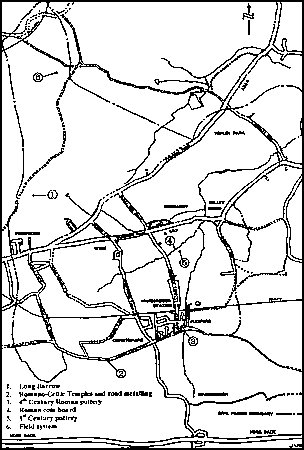|
The excavation of a Roman villa in 1829 on Broadstreet Common (an area just outside the Normandy boundary) is on record and although the age of the villa could only be estimated by the recovery of coins, one of which had been minted in A.D. 286 - 293, the supposition was that the area had been occupied during this period with road communication in both an easterly and westerly direction. Until fairly recently firm evidence for early human occupation in the Normandy area was lacking. Certainly the odd worked flint had been found also the suggestion of a Neolithic long barrow located during the construction of an earth-fort by the Army on Normandy Hill. Then in 1908 a small hoard of Roman coins (folles) dating between AD296 and 312 (placed in a small bead rim jar), was found in the bank of the stream which passes under Glaziers Lane. Interest in Archaeological finds was re-kindled following the end of WWII when Judith Turner of Flexford Farm, Normandy found a number of 4th century Roman shards in her garden. Within a few years such interest escalated with the introduction and popularity of metal detecting; many users of which were to be seen at the weekend quartering and scanning the fields hereabouts. Local History Groups and Archaeological Societies saw a welcome increase in membership numbers. All this changed in 1968 when it was reported that a substantial quantity
of Roman pottery had been found in a field to the south of Green Lane near
the known site of a Romano-Celtic temple believed similar to that at Farley
Green in Surrey. Some 15 years later, the discovery of deposits of ancient
coinage in nearby fields resulted in a disturbing period of vandalism and
theft generated by greed to recover and illegally dispose of the previously
hoarded coins, then globally valued at extremely high figures. Expert testimony
at subsequent 'treasure-trove' legal trials, particularly pertinent to the
coinage and artefacts removed without authority from this site in Green
Lane East and sold clandestinely here in Britain and on the continent, influenced
the Crown Prosecution Service to change the then current law on treasure-trove. These discoveries have been fully recorded and published in various Medias, all adding to the volume of knowledge of the early occupiers of these Isles in the 3rd and 4th Centuries and their religious fervours, particularly the merging of their respective beliefs in the Roman Gods and early Christianity. During the excavation of the temples, evidence was found of a metalled road surface on the line of Green Lane. In consideration of this together with the finds at Flexford and the suspiciously straight sections of Green Lane and Flexford Road, it suggests that this "green route", extensively used during the Middle Ages, may be of Roman origin. This "road" is thought to have run from Ewell to Neatham, near Alton, possibly via the potteries at Farnham. The next happening was the archaeological evaluation of Manor Fruit Farm in 1999 ahead of the Parish development of the site. Although nothing significant was found on the actual site a ground survey of adjacent land including the Elms Gardens property revealed a drainage trench consisting of a black ashy deposit containing over 50 shards of 1st Century pottery. The distribution of pottery associated with this deposit also spread northwards along the Glaziers Lane stream mentioned above. The finds were interpreted as a midden deposit (refuse dump associated with being close to contemporary occupation), and is the best indication so far of a probable settlement in this area during the Roman Occupation period of "Britannia". Starting in 2000, the Surrey County Council embarked upon the restoration and regeneration of large areas of heath including the Wyke and Cleygate Commons. During one survey, a series of very slight banks, close to the Trig Point on Romping Downs (SU 91065371 refers), were observed which might represent the remains of a field system. Given the present marginal nature of the land in agricultural terms it is considered possible that these traces are of considerable age and may be Romano-British or even prehistoric in origin. Jack Kinder
|

